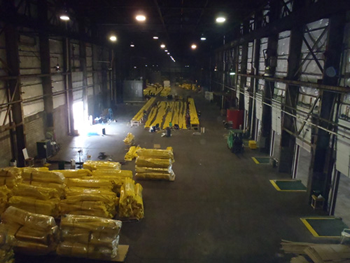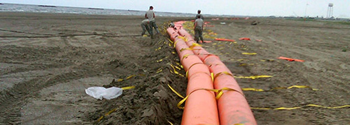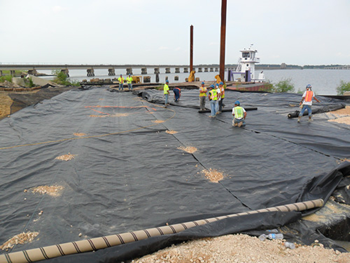 |
The largest marine oil spill accident ever is over–or is it? BP, the energy giant responsible for the blunder at the now infamous Macondo well, located off the coast of Louisiana in the Gulf of Mexico, finally declared the troublesome well officially dead in September 2010.
The well, also known as MC252, was blocked with a temporary cap on July 15, 86 days after the explosion of the Deepwater Horizon Drilling Rig caused it to rupture and begin spewing crude oil into the gulf. On September 17, using two relief wells, BP pumped mud and cement into the MC252 well to choke the flow of oil and gas permanently. Then, they breathed a huge sigh of relief.
But those of us who have been heavily involved in cleaning up the largest environmental disaster in U.S. history know that the job is far from done. Two hundred and six million gallons (4.9 million barrels) of oil blanketed the ocean waters, suffocated scores of marine life and marred the shores of Louisiana, Texas, Mississippi, Alabama, Florida and the Intracoastal Waterway. The quantity of oil spilled in this disaster is 19 times more than that of the 1989 Exxon Valdez spill in the waters of Prince William Sound in Alaska. The Exxon Valdez spill caused sharp reductions in marine wildlife populations and damage to shoreline arctic habitats that is anticipated to last at least 30 years.
Though the oil visible on the surface of the Gulf is gone, scientists have confirmed that plumes of oil still lurk beneath the water’s surface and they have recently found large deposits of oil on the ocean floor. Continued dedication to the cleanup effort will impact the future prosperity of the affected coastal communities, rich marshlands and wildlife breeding grounds, and abundant marine habitats.
Numerous types of equipment and technologies have been deployed to aid in cleaning the affected Gulf region. Among them are various types of geomembranes. In more ways than one, geomembranes have been vital to curbing the environmental damage caused by the spill. The following information details the distinct applications of geomembrane products in the Gulf cleanup effort.
OIL BOOMS
Probably the most widely known application of geomembranes is the oil containment boom. In almost any oil spill, it is one of the first products deployed to aid in corralling the oil. Booms float on the surface of the water and extend a total of 18-48 inches (0.46m – 1.2m), partly beneath the surface of the water.
Booms have three components: flotation, draft and ballast. The flotation device, typically a round hard foam piece, is encapsulated in a geomembrane fabric, which also extends beneath the flotation device and below the water’s surface to act as the draft. The ballast is a chain or weight fabricated into the bottom of the draft to weigh it down.
Containment booms are used to concentrate oil in thicker surface layers so that skimmers, vacuums and other oil collection methods can be used more effectively. Booms can function to divert oil to a particular place or block the oil from contaminating a sensitive area. Containment booms are most effective in relatively calm waters.
Geomembrane Product: Containment booms can be manufactured in different shapes and sizes to address different types of water conditions. Typically, booms are made from a 22-ounce or heavier PVC-reinforced geomembrane. Certain applications call for a polyurethane based product or an ethylene copolymer geomembrane product. Standard colors are bright yellow or orange.
Role in the BP Oil Spill Cleanup Effort: For containment purposes, approximately four million feet of boom was deployed during the height of the oil spill. During the peak cleanup effort, oil boom supplies became very limited. Initially, BP sought boom products from around the world, including from China, Brazil, Norway, Sweden, France and Finland, before settling into contracts with U.S. suppliers. Sufficient quantities of raw materials were difficult to find (prices fluctuated). Normally buyers pay about six dollars per foot of boom. But in the peak of the cleanup effort, BP paid over ten dollars per foot. Because of supply issues, booms of all colors were accepted. According to BP, 827,046 barrels of oily liquid were skimmed from the surface using containment booms.
FIRE BOOMS
Fire booms provide a barrier to collect and contain floating oil so that it can be burned at sea. Fire booms are U-shaped, inflatable and flexible. Two support vessels tow a fire boom, pumping water through it via discharge hoses that connect to pumps on each end of the boom. Two boats towing a standard sized fire boom through an oil slick can gather about 75,000 gallons (1,800 barrels) of oil at a time. This oil is dragged away from the larger spill, ignited and burned. Pumping water through the booms during the burning keeps them cool enough to preserve them for reuse.
Geomembrane Product: Fire booms are made of a specialized reinforced geomembrane fabric that can contain burning oil and resist its flame up to 2,000 degrees Fahrenheit. They are typically manufactured to be 500 feet long.
Role in the BP Oil Spill Cleanup Effort: According to BP, more than 400 controlled surface burns were conducted using fire booms to prevent the spread of oil and flames. These burns successfully eliminated 265,450 barrels of oil in the Gulf.
TIGER DAMS
 |
A Tiger Dam is a patent-protected system developed by U.S. Flood Control to replace sandbags for controlling floodwaters. Tiger Dams are cylindrical tubes made with geomembrane fabric that can be laid out side by side, or in the form of a pyramid with two tubes on the bottom and one in the middle on top. In pyramid form, they can be stacked up to 32 feet high. Tiger Dams serve as a barrier between water and land. They are flexible and can be laid out straight or in a zigzag fashion along varying terrain and waterways.
Tiger Dams had never before been used in oil spill cleanup efforts prior to the spill caused by the April 2010 explosion of the Deepwater Horizon Oil Rig. In this cleanup effort, Tiger Dams have been successfully used along shorelines to stop oil migration into the wetlands and sand dunes and to protect beaches and barrier islands. They are filled with water (as opposed to the concrete that is often used in flood control) and have anchors that keep them in place. Tiger Dams are a safe, reusable and more efficient alternative to sandbags.
Geomembrane Product: Tiger dams are made with a 28-ounce PVC-reinforced geomembrane fabric. The cylindrical tubes of Tiger Dams are typically 50 foot by 19 inches. They can be interconnected to form a barrier of infi
nite length.
Role in the BP Oil Spill Cleanup Effort: BP installed 10 miles (using 30 miles of geomembrane fabric) of Tiger Dams along Louisiana’s Grand Isle Beach, the beach located along Louisiana’s southern most shores. BP set up the Tiger Dams to hold back oil and protect sensitive waterfront areas and properties. BP used water directly from the Gulf of Mexico to fill the Tiger Dams.
CONTAINMENT BLADDERS FOR SKIMMERS & WATER-BASED DECONTAMINATION SYSTEMS
Containment bladders are fabricated bags that are pulled behind skimmers to contain oil that is extracted from the water. Once the bag is full, the skimmers deliver it to shore where it is sent for proper disposal.
Geomembrane Product: Containment bladders are normally made with a minimum 30-ounce reinforced PVC or polyurethane based geomembrane product.
Role in the BP Oil Spill Cleanup Effort: Containment bladders have been pulled behind smaller skimmers that travel small inlets and tight waterways along the Gulf where large boats cannot pass.
TEMPORARY SPILL BERMS
 |
Temporary Spill Berms are small units with fold-up sides that serve as wash down, storage and temporary spill containment contain leaks from oil containers, drums and even vehicles. These spill berms are portable and can be used for loading and unloading stations.
Geomembrane Product: Temporary Spill Berms are made with a minimum of 30-ounce reinforced geomembrane product.
Role in the BP Oil Spill Cleanup Effort: Temporary Spill Berms have been used in loading, unloading and fueling stations along the Gulf of Mexico.
DECONTAMINATION STATIONS
Decontamination stations are locations along the shore where boats, containment booms, skimmers and other equipment can be cleaned and repaired before they are redeployed in the ocean for additional cleanup work. Geomembranes are used to line the decontamination pit and are topped with gravel, concrete or asphalt to create a working surface for the equipment driving in and out of station.
Geomembrane Product Used: Decontamination stations use a minimum 30-mil reinforced geomembrane product to protect the earth. Because they are built as more permanent stations, they must have a surface that is suitable to support moving trucks and heavy equipment. The geomembrane, thus, is covered with gravel, asphalt or concrete.
Role in the BP Oil Spill Cleanup Effort: BP has built seven decontamination stations along the coast, the majority of which are located in Alabama and Mississippi.
For more information about Fabricated Geomembrane Systems please contact Bill Shehane by phone at +1 330 262 1111 extension 3003 or email at bshehane@seamancorp.com. For more information on geomembranes, see also www.xr-5.com.











